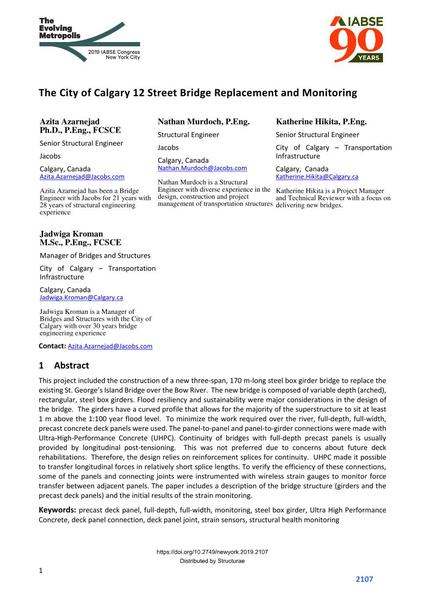The City of Calgary 12 Street Bridge Replacement and Monitoring

|
|
|||||||||||
Bibliografische Angaben
| Autor(en): |
Azita Azarnejad
(Jacobs)
Nathan Murdoch (Jacobs) Katherine Hikita (City of Calgary – Transportation Infrastructure) Jadwiga Kroman (City of Calgary – Transportation Infrastructure) |
||||
|---|---|---|---|---|---|
| Medium: | Tagungsbeitrag | ||||
| Sprache(n): | Englisch | ||||
| Tagung: | IABSE Congress: The Evolving Metropolis, New York, NY, USA, 4-6 September 2019 | ||||
| Veröffentlicht in: | The Evolving Metropolis | ||||
|
|||||
| Seite(n): | 2107-2113 | ||||
| Anzahl der Seiten (im PDF): | 7 | ||||
| DOI: | 10.2749/newyork.2019.2107 | ||||
| Abstrakt: |
This project included the construction of a new three-span, 170 m-long steel box girder bridge to replace the existing St. George’s Island Bridge over the Bow River. The new bridge is composed of variable depth (arched), rectangular, steel box girders. Flood resiliency and sustainability were major considerations in the design of the bridge. The girders have a curved profile that allows for the majority of the superstructure to sit at least 1 m above the 1:100 year flood level. To minimize the work required over the river, full-depth, full-width, precast concrete deck panels were used. The panel-to-panel and panel-to-girder connections were made with Ultra-High-Performance Concrete (UHPC). Continuity of bridges with full-depth precast panels is usually provided by longitudinal post-tensioning. This was not preferred due to concerns about future deck rehabilitations. Therefore, the design relies on reinforcement splices for continuity. UHPC made it possible to transfer longitudinal forces in relatively short splice lengths. To verify the efficiency of these connections, some of the panels and connecting joints were instrumented with wireless strain gauges to monitor force transfer between adjacent panels. The paper includes a description of the bridge structure (girders and the precast deck panels) and the initial results of the strain monitoring. |
||||
| Stichwörter: |
ultrahochfester Beton Stahlhohlkästen Monitoring
|
||||
